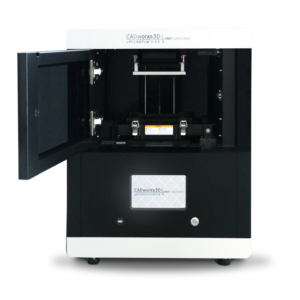Overview
- Our DLP 3D Printer is specifically turned for microfluidics applications
- Choose from two different purpose-specific resins:
- "Mastermold" for use in conjunction with PDMS part fabrication
- "Clear " for monolithic device fabrication
TEAM lab hardware
CADworks3D ProFluidics 285D

Build Volume: 110 (length) x 62 (width) x 120 (height) mm
Maximum suggested build platform usage for single build: 75%
Maximum suggested part aspect ratio: 5:1 (add outside corner fillets if working at/near/above this value)
Pixel Size: 40µm native, 28.5µm dynamic
Wavelength: 385 nm
Z-Height Resolution: 5-500µm
Commonly Z-Heights: 50µm OR 30µm
Minimum Suggested Encapsulated Channel Diameter (clear resin): 80µm
Materials: "Mastermold" for PDMS molding applications, "Clear" for direct-use microfluidic applications (biocompatible, inert under florescent light)
Unique Properties:
- Hardware and materials specifically tuned for microfluidic applications
Applications

Materials
Our DLP 3D printing materials are uniquely tuned for microfluidics applications. Choose from either "Master Mold," or "Clear" resin depending on your application.
MasterMold
MasterMold by CADworks3D is a specialized resin designed for creating high-resolution master molds for PDMS microfluidic Ideal for creating PDMS molds with features as small as 50µm. It provides a fine surface finish (0.18µm Ra value) that ensures optical clarity, proper bonding, and prevents leaking during testing. When casting PDMS, no cytotoxic residual material is transferred, making it biocompatible and suitable for cell culture applications. Master molds can withstand lab oven temperatures and can be used multiple times to cast up to 500 PDMS devices.
Clear Microfluidics Resin
This resin is specially formulated with low viscosity for easy drainage of enclosed channels during printing and cleaning. This resin enables precise, high-resolution printing of micro-sized features, making it ideal for prototyping and lab-on-a-chip applications.
The resin is also specifically developed for maximum biocompatibility, and optical clarity. The material is also inert under florescent lighting.


Comparison to other printing technologies
Contrasted with FDM
These technologies have very distinct applications with minimal overlap.
Contrasted with Reinforced FDM
These technologies have very distinct applications with minimal overlap.
Contrasted with SLA or MSLA (Resin Printing)
While SLA/MSLA can handle light-duty microfluidics, the materials and hardware shown here are far better suited for these applications. DLP printing offers higher resolution, and the resins used have lower viscosity and much smoother surface finishes, making them ideal for precise microfluidic structures.
Contrasted with Polyjet
These technologies have very distinct applications with minimal overlap.
Examples
MasterMold


Clear Encapsulated Microfluidic Device



DLP Microfluidics Printing Gallery
Click here to view more example DLP Microfluidics prints.
Rates
- Note: We strongly recommend submitting a service request to obtain an accurate project cost estimate. Self-quoting can often lead to miscalculations
We bill for time and materials while using our DLP printer. For time, we assess 1 hour of assisted time per-request plus an hourly rate for machine use.
| Description | Internal | External | |
| Materials | Per-ml expense for economy materials in-stock (Clear Resin, Master-Mold resin) | $0.60/ml | $0.80/ml |
| Setup and Processing | 1 hours of our assisted rate ($119/hour) per request (not object) | $119/request | $160/request |
| Hourly Use Rate | Expense per hour of machine use | $6/hour | $8/hour |
Technical Details:
Designing for DLP Printing:
Formulated with low viscosity for easy drainage of enclosed channels during printing and cleaning. This resin enables precise, high-resolution printing of micro-sized features, making it ideal for prototyping and lab-on-a-chip applications.
Part Thickness
DLP prints are best kept small to small/medium scale, with wall thicknesses between 1-5mm. Thicker parts may result in surface imperfections like rashing or ragging and can lead to dimensional inconsistencies. A minimum wall thickness of 0.5mm is recommended to ensure structural integrity.
Support Structure
Parts can be, and are typically printed directly on the build plate but they may also be elevated using support structures. Printing directly on the build plate will usually cause a subtle defect at the outside edge along the base known as "elephant’s foot." Support structures are necessary for stabilizing parts with overhangs during printing (much like SLA/MSLA). The contact points of the supports may leave small defects that can be sanded down for a smooth finish.
Preparing Files for Printing:
The team lab suggests two sets of files for each 3D printed part (where possible) – the original parametric model file (Solidworks/Inventor/Fusion360/etc), and a millimeter scale STL file (point-mesh file). Please include these files on your project request if possible.
Get Started
- Heard enough? Get started with a service request! Your request need-not be perfect, we can always revise it as we go. Just provide us with as much detail as is necessary.
- Feeling overwhelmed with the options? We don't blame you! We do a lot! Feel free to email us to set up a consultation. We're happy to chat via zoom, or in person (where we can review samples).
